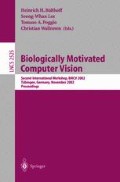Abstract
Using psychophysics we investigated to what extent human face recognition relies on local information in parts (featural information) and on their spatial relations (configural information). This is particularly relevant for biologically motivated computer vision since recent approaches have started considering such featural information. In Experiment 1 we showed that previously learnt faces could be recognized by human subjects when they were scrambled into constituent parts. This result clearly indicates a role of featural information. Then we determined the blur level that made the scrambled part versions impossible to recognize. This blur level was applied to whole faces in order to create configural versions that by definition do not contain featural information. We showed that configural versions of previously learnt faces could be recognized reliably. In Experiment 2 we replicated these results for familiar face recognition. Both Experiments provide evidence in favor of the view that recognition of familiar and unfamiliar faces relies on featural and configural information. Furthermore, the balance between the two does not differ for familiar and unfamiliar faces. We propose an integrative model of familiar and unfamiliar face recognition and discuss implications for biologically motivated computer vision algorithms for face recognition.
AS was supported by a grant from the European Commission (IST Programme).
Access this chapter
Tax calculation will be finalised at checkout
Purchases are for personal use only
Preview
Unable to display preview. Download preview PDF.
References
Heisele, B., Serre, T., Pontil, M., Vetter, T., and Poggio, T. (2001). Categorization by learning and combining object parts. NIPS proceedings.
Lee, D.D., & Seung, S. (1999). Learning the parts of objects by non-negative matrix factorization. Nature, 401, 788–791.
Ullman, S., & Sali, E. (2000). Object Classification Using a Fragment-Based Representation. BMCV 2000. Lecture Notes in Computer Science, 1811, pp. 73–87. Berlin: Springer.
Tanaka J. W. & Farah, M. J. (1991). Second-order relational properties and the inversion-effect: Testing a theory of face perception. Perception & Psychophysics, 50, 367–372.
Tanaka, J. W. & Farah, M. J. (1993). Parts and wholes in face recognition. Quarterly Journal of Experimental Psychology, 79, 471–491.
Farah, M. J., Tanaka, J. W., & Drain, H. M. (1995). What causes the face inversion effect? Journal of Experimental Psychology: Human Perception and Performance, 21, (3), 628–634.
Lades, M., Vorbrüggen, J.C., Buhmann, J., Lange, J., Malsburg, v.d., C., Würtz, R.P., & Konen, W. (1993). Distortion invariant object recognition in the dynamic link architecture. IEEE Transactions on Computers, 42, 300–311.
Wiskott, L., Fellous, J.M., Krüger, N., & von der Malsburg, C. (1997). Face Recognition by Elastic Bunch Graph Matching. IEEE Transactions on Pattern Analysis and Machine Intelligence, 19(7), 775–779.
Biedermann, I., & Kalocsai, P. (1997). Neurocomputational bases of object and face recognition. Philosophical Transactions of the Royal Society of London, B, 352, 1203–1219.
Rhodes, G., Brake, S., & Atkinson, A.P. (1993). What’s lost in inverted faces? Cognition, 47, 25–57.
Rakover, S. S. (2002). Featural vs. configurational information in faces: A conceptual and empirical analysis. British Journal of Psychology, 93, 1–30.
Collishaw, S.M., Hole G.J. (2000). Featural and configurational processes in the recognition of faces of different familiarity. Perception, 29, 893–910.
Davidoff, J., & Donnelly, N. (1990). Object superiority: a comparison of complete and part probes, Acta Psychologica, 73 1990 225–243.
Sergent J. (1985). Influence of task and input factors on hemispheric involvement in face processing. Journal of Experimental Psychology: Human Perception and Performance, 11(6), 846–61.
Green, D.M., & Swets, J.A. (1966). Signal detection theory and psychophysics. New York: Wiley.
McMillan, N.A., & Creelman, C.D. (1992). Detection theory: A user’s guide. New York: Cambridge University Press.
Benton AL, 1980. The neuropsychology of facial recognition. American Psychologist, 35, 176–186.
Malone D.R., Morris H.H., Kay M.C., Levin, H.S., 1982. Prosopagnosia: a double dissociation between the recognition of familiar and unfamiliar faces. Journal of Neurology, Neurosurgery, and Psychiatry, 45, 820–822.
Ellis, H.D., Shepherd, J.W., Davies G.M., 1979. Identification of familiar and unfamiliar faces from internal and external features: some implications for theories of face recognition. Perception, 8, 431–439
Yarmey, A.D., 1971. Recognition memory for familiar “public” faces: Effects of orientation and delay. Psychonomic Science, 24, 286–288.
Hasselmo, M.E., Rolls, E.T., & Baylis, C.G. (1989). The role of expression and identity in the face-selective responses of neurons in the temporal visual cortex of the monkey. Experimental Brain Research, 32, 203–218.
Perret, D.I., Hietanen, J.K., Oram, M.W., & Benson, P.J. (1992). Organization and functions of cells in the macaque temporal cortex. Philosophical Transactions of the Royal Society of London, B, 335, 23–50.
Perret, D.I., Rolls, E.T., & Caan, W. (1982). Visual neurones responsive to faces in the monkey temporal cortex. Experimental Brain Research, 47, 329–342.
Perret, D.I., Mistlin, A.J., & Chitty, A.J. (1987). Visual neurones responsive to faces. Trends in Neuroscience, 10, 358–364.
Perret, D.I., & Oram, M.W. (1993). Image Vis. Comput., 11, 317–333.
Wachsmuth, E., Oram, M.W., & Perret, D.I. (1994). Recognition of objects and their component parts: responses of single units in the temporal cortex of the macaque. Cerebral Cortex, 4, 509–522.
Yamane, S., Kaji, S., & Kawano, K. (1988). What facial features activate face neurons in the inferotemporal cortex of the monkey? Experimental Brain Research, 73, 209–214.
Schwaninger, Lobmaier, & Collishaw (2002). Role and interaction of featural and configural processing in face recognition. Vision Sciences Society, 2nd annual meeting, Sarasota, Florida, May 10–15, 2002.
Author information
Authors and Affiliations
Editor information
Editors and Affiliations
Rights and permissions
Copyright information
© 2002 Springer-Verlag Berlin Heidelberg
About this paper
Cite this paper
Schwaninger, A., Lobmaier, J.S., Collishaw, S.M. (2002). Role of Featural and Configural Information in Familiar and Unfamiliar Face Recognition. In: Bülthoff, H.H., Wallraven, C., Lee, SW., Poggio, T.A. (eds) Biologically Motivated Computer Vision. BMCV 2002. Lecture Notes in Computer Science, vol 2525. Springer, Berlin, Heidelberg. https://doi.org/10.1007/3-540-36181-2_64
Download citation
DOI: https://doi.org/10.1007/3-540-36181-2_64
Published:
Publisher Name: Springer, Berlin, Heidelberg
Print ISBN: 978-3-540-00174-4
Online ISBN: 978-3-540-36181-7
eBook Packages: Springer Book Archive

